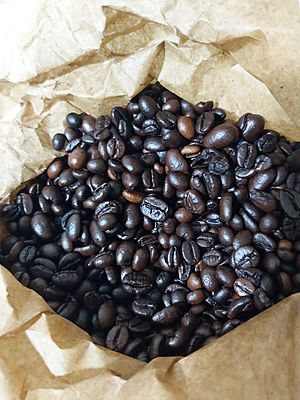Sagada coffee facts for kids
Quick facts for kids Sagada coffee |
|
|---|---|

Coffee beans from Sagada province
|
|
| Species | Coffea arabica |
| Origin | Sagada, Cordillera, the Philippines |
Sagada coffee, also known as Sagada arabica, is a special type of coffee. It comes from the high mountains of Sagada in the northern Philippines. This coffee is a kind of Coffea arabica, specifically the Typica variety. It is called "single-origin" because it all comes from one specific place.
Contents
The Story of Sagada Coffee
How Coffee Came to Sagada
Arabica coffee first arrived in Sagada in the late 1800s. This was later than in other parts of the Philippines. Coffee had been brought to the lowlands earlier during the time when Spain ruled the Philippines.
Sagada was not well-known to the Spanish government until 1847. Because of this, it did not have much contact with them before then. This is why coffee came to Sagada later.
Who Brought Coffee to Sagada?
There are different stories about how arabica coffee came to Sagada. Many people say it was Jaime P. Masferré. He was a retired Spanish soldier from Catalonia, a region in Spain. He used to be a commander in the Guardia Civil, a police force.
Jaime Masferré married Mercedes Cunyap Langkew, a woman from Sagada. In the late 1890s, he started a farm in Batalao town. This was after Spain gave control of the Philippines to the United States. He grew different plants like citrus trees and chayote. He also grew arabica coffee, possibly from the Benguet area. His coffee plants are believed to have spread to local communities.
Jaime Masferré's son, Eduardo Masferré, also became famous. He is known as the "father of Philippine photography."
Coffee Spreads North
Coffee trees also spread to the northern parts of Sagada. This happened because of Okoi, a carpenter from Japan. He worked for American missionaries in the village of Fidelisan. Okoi became friends with Masferré and got coffee seedlings from him. He then planted these seedlings in Fidelisan.
Growing Sagada Coffee
Where Sagada Coffee Grows
Most Sagada coffee is grown in Sagada and Besao towns. Both are in Mountain Province, located in northern Luzon. The climate in the Cordillera highlands of Sagada is perfect for growing arabica coffee. This is similar to the Benguet area.
Since the early 1900s, most coffee has been grown in small farms. These are often in the backyards of Sagada families. In Fidelisan, some coffee trees are over 100 years old and still produce beans!
Traditional Ways of Growing Coffee
Most of the coffee was used by the local people. If they had extra beans, they would trade them with traveling merchants. They also traded coffee beans for other goods from local shops.
Growing and harvesting Sagada coffee was traditionally done by women. Often, the whole community would help. Sagada coffee is known for its bittersweet taste. It also has hints of fruit or flowers.
Challenges and Future of Sagada Coffee
Sagada coffee is hard to find, even in local markets. This is because there have not been many large coffee farms until recently. The government is now trying to encourage more people to grow it. They offer training and equipment to farmers.
In Sagada, there is a local rule that every household must plant at least five Sagada coffee trees. Before a couple can get a marriage license, they also need to plant the same number of trees. However, the coffee industry still faces challenges. Many people do not know about Sagada coffee, and local demand is still low.

